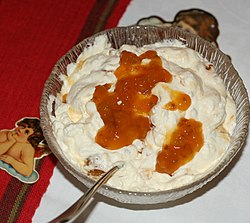
Porridge is a food made by heating or boiling ground, crushed or chopped starchy plants, typically grain, in milk or water. It is often cooked or served with added flavourings such as sugar, honey, fruit, or syrup to make a sweet cereal, or it can be mixed with spices, meat, or vegetables to make a savoury dish. It is usually served hot in a bowl, depending on its consistency. Oat porridge, or oatmeal, is one of the most common types of porridge. Gruel is a thinner version of porridge and congee is a savoury variation of porridge of Asian origin.

Rubus chamaemorus is a species of flowering plant in the rose family Rosaceae, native to cool temperate regions, alpine and Arctic tundra and boreal forest. This herbaceous perennial produces amber-colored edible fruit similar to the blackberry. English common names include cloudberry, Nordic berry, bakeapple, knotberry and knoutberry, aqpik or low-bush salmonberry, and averin or evron.

Finnish cuisine is notable for generally combining traditional country fare and haute cuisine with contemporary continental-style cooking. Fish and meat play a prominent role in traditional Finnish dishes in some parts of the country, while the dishes elsewhere have traditionally included various vegetables and mushrooms. Evacuees from Karelia contributed to foods in other parts of Finland in the aftermath of the Continuation War.

Bread cheese, known in the United States as Finnish squeaky cheese, is a Finnish fresh cheese traditionally made from cow's colostrum. In America, cow's milk is generally used but can also be made with goat milk. Commercially available versions are typically made from cow's milk. The cheese originally comes from Southern Ostrobothnia, Northern Finland, and Kainuu.
Uunijuusto is a Finnish dish made from cow's colostrum, the first milk of a calved cow, salted and baked. Sometimes uunijuusto is also made from ordinary milk and eggs. In Sweden, the dish is named kalvdans.

Rice pudding is a dish made from rice mixed with water or milk and commonly other ingredients such as sweeteners, spices, flavourings and sometimes eggs.

Baked Alaska, also known as Bombe Alaska, omelette norvégienne, omelette surprise, or omelette sibérienne depending on the country, is a dessert consisting of ice cream and cake topped with browned meringue. The dish is made of ice cream placed in a pie dish, lined with slices of sponge cake or Christmas pudding, and topped with meringue. After having been placed in the freezer, the entire dessert is then placed in an extremely hot oven for a brief time, long enough to firm and caramelize the meringue but not long enough to begin melting the ice cream.

A Swiss roll, jelly roll, roll cake, cream roll, roulade or Swiss log is a type of rolled sponge cake filled with whipped cream, jam, icing, or any type of filling. The origins of the term are unclear; in spite of the name "Swiss roll", the cake is believed to have originated elsewhere in Central Europe, possibly Austria or Slovenia. It appears to have been invented in the nineteenth century, along with Battenberg cake, doughnuts, and Victoria sponge. In the U.S., commercial snack-sized versions of the cake are sold with the brand names Ho Hos, Yodels, Swiss Cake Rolls, and others. A type of roll cake called Yule log is traditionally served at Christmas.
Norwegian cuisine in its traditional form is based largely on the raw materials readily available in Norway and its mountains, wilderness, and coast. It differs in many respects from continental cuisine through the stronger focus on game and fish. Many of the traditional dishes are the result of using conserved materials, necessary because of the long winters.

Krumkake is a Norwegian waffle cookie made of flour, butter, eggs, sugar, and cream.

Ostkaka, ost meaning "cheese" and kaka meaning "cake" in Swedish, is known as Swedish cheesecake or Swedish curd cake, it is a Swedish dessert that has its roots in two different parts of Sweden, Hälsingland and Småland, though there are some differences between ostkaka from Hälsingland resembling halloumi in texture, and the soft-grained ostkaka from Småland.Originally, the food comes from småland, ostkaka is made with raw milk and cheese rennet. However, these days most people simply use cottage cheese instead, which is much faster, and gives the same flavor and texture.

Sámi cuisine is the cuisine of peoples from the Sápmi territory of the Sámi people, which spans Norway, Sweden, Finland and Russia. Its traditional cuisine of each area has individual traits.

Alaskan ice cream is a dessert made by Alaskan Athabaskans and other Alaska Natives.
Fruktsoppa is a fruit soup that is typically prepared using dried fruits, and usually served as a dessert dish. The dish has been described as a "cold fruit pudding." It is a traditional dessert in Sweden and Norway. Historically, during the winter months in Scandinavian countries, fresh fruit was generally unavailable, so people used dried fruits for the preparation of various dishes, including fruktsoppa. The soup may be served hot or cold. The soup can be made with one fruit or with multiple fruits; a soup which is made with multiple fruits may be called blandad fruktsoppa, which is Swedish for "mixed fruit soup".











